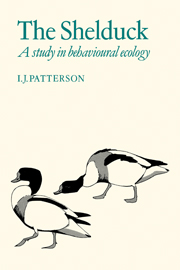Book contents
- Frontmatter
- Contents
- Acknowledgments
- 1 Introduction
- 2 The shelduck
- 3 Gregariousness: the winter flock
- 4 Territories
- 5 Prospecting for nest sites
- 6 Laying and incubation
- 7 Care of the young
- 8 Duckling survival
- 9 Recruitment and the non-territorial flock
- 10 The limitation of shelduck populations
- References
- Subject index
- Author index
7 - Care of the young
Published online by Cambridge University Press: 04 August 2010
- Frontmatter
- Contents
- Acknowledgments
- 1 Introduction
- 2 The shelduck
- 3 Gregariousness: the winter flock
- 4 Territories
- 5 Prospecting for nest sites
- 6 Laying and incubation
- 7 Care of the young
- 8 Duckling survival
- 9 Recruitment and the non-territorial flock
- 10 The limitation of shelduck populations
- References
- Subject index
- Author index
Summary
Parental behaviour normally involves a number of different activities: feeding the young, providing them with shelter and protecting them from predators and other dangers. By investing time and energy in this behaviour, even at some risk to their own chance of survival, the adults enhance their genetic fitness by increasing the survival of their progeny. Shelducks, like other parents of precocial young, do not feed their broods but merely accompany them while they feed themselves. The parents do, however, actively provide shelter and protection as I shall describe in this chapter.
Leaving the nest
Newly hatched young shelducks stay in the nest for some time, usually for at least 12 h and up to four days if there is a wide spread of hatching date within the clutch (Hori, 1964a). During this period, ducklings and female call frequently. Hori was able to approach very close to a nest inside a shed and described a monosyllabic ‘aarrk’ and a soft running ‘ugg ugg ugg’ given continuously for long periods by the female. I installed a microphone in a nest burrow over the hatching period and heard similar calls, along with piping responses from the ducklings. All of the calls are given very softly and can only be heard at very close range. It is likely that the ducklings become imprinted on the mother's voice while in the nest (Gottlieb, 1965). Since the ducklings' first hours are spent in the dark, it is obviously functional to use auditory rather than visual characteristics of the mother as a basis for imprinting.
- Type
- Chapter
- Information
- The ShelduckA Study in Behavioural Ecology, pp. 161 - 185Publisher: Cambridge University PressPrint publication year: 1982



